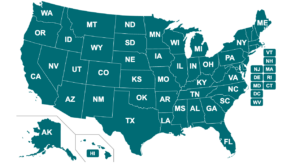
Message from Carol
Dear Colleagues:
In late May, we were honored with a visit from Energy Secretary Chris Wright, his chief of staff Carl Coe, and other members of his staff. It was a unique opportunity for us to learn more about the Secretary’s priorities and those of the Administration, and for our Lab to present, firsthand, our capabilities, our value, and our impact. The Secretary and his team were able to visit many research projects and user facilities. The Secretary also co-led a press conference with Dell Technologies and NVIDIA, announcing the NERSC-10 partnership to build the next flagship supercomputer at the NERSC user facility.
The visit was very well received, thanks to all the hard work that many of you put into preparations. It underscored the importance that we all play, not just in research and operations, but also as ambassadors for the Lab. It reminded me that we could all learn more about the many ways we are having an impact, and how to communicate the value of our work to our own networks and communities.
We make an impact on society in many ways. Of course, we have great breakthroughs in many research fields across the Lab. We are finding ways to revolutionize how science is done; examples include our multidisciplinary and transdisciplinary approaches to science, using new computational tools such as artificial intelligence and machine learning, and the development of new scientific tools including quantum computing. We are also playing an important role in building the skills that tomorrow’s scientific workforce will need. For example, in this issue, you’ll read about how the K-12 program has been training students in artificial intelligence and machine learning.
We are also leaders in innovation. Recently, we celebrated the 10th anniversary of the DOE’s Lab-Embedded Entrepreneurship Program (LEEP). Companies supported by Cyclotron Road, the Lab’s LEEP node, recently exceeded $3 billion in follow-on funding. Our technologies are making a significant impact in the marketplace, with dozens of companies like Sepion and Sunchem, featured in this issue, taking Lab inventions to market. And, on June 24, Jay Keasling, Biosciences Area senior faculty scientist and CEO of the Joint BioEnergy Institute (JBEI), was honored with the DOE’s Office of Technology Commercialization (OTC) and the National Academy of Inventors (NAI) 2025 OTC-NAI Innovator of the Year Award.
Our Strategic Communications team and communicators across the Lab regularly write stories about the impact our work has on society. I encourage you to read these stories, so that you are better informed about your colleagues’ accomplishments and can share them with your own networks. This issue of Research News includes some stories about the impact of many of our user facilities and research projects.
Every day, I discover something new to appreciate about the Lab and share with my network. I know you will join me in helping to communicate the many ways the Lab is impacting society. Thank you for your commitment to our mission.
Sincerely,
Carol Burns
Deputy Laboratory Director for Research
Chief Research Officer

Impact Map: Our Contributions to the 50 States
Are you curious about the Lab’s impact in your home state or in other states across the U.S.? View the state impact map, which describes some of these contributions.

Berkeley Lab Startups Make an Impact
Startups founded on Berkeley Lab intellectual property are an important way the Lab brings science solutions to the world. In fact, more than 80 startups have been launched with Berkeley Lab inventions in the last three decades.
Sunchem is a startup making strides in recovering critical metals from waste streams. CEO Daniel Sun, a former researcher at the Molecular Foundry, is leveraging technology developed at the Lab to extract critical metals like gold and copper. With a technology license and support from the Lab’s Cyclotron Road and Founders Factory (funded by mining giant Rio Tinto), Sunchem shows how Lab innovations can drive real-world impact.
Sepion, a startup founded in 2015 on battery membrane technology developed by Brett Helms and Peter Frischmann at the Molecular Foundry and the DOE’s Joint Center for Energy Storage Research, recently announced plans for a manufacturing facility to build low-cost, high-performing separators. Technology research and development were key, as was the entrepreneurship support provided along the way by the Lab and DOE.

K-12 Office Helps Build Tomorrow’s AI/ML Workforce
Artificial intelligence (AI) and machine learning (ML) are critical skills for today’s and tomorrow’s scientists. So much so that the White House recently announced a presidential action in support of AI education for American youth. The Department of Energy is also focused on building an AI-ready workforce. At Berkeley Lab, the K-12 team has already been providing data science and AI/ML training for the past five years. Since 2020, they have provided this training to more than 100 students, building skills and encouraging interest in data science, AI, and ML.
NEED TO KNOW
SPO Reminder: Research Partner, Sponsor, and Donor Representations and Certifications Requirement
The Department of Energy (DOE) mandates that all sponsors and donors undergo recertification every two years. Berkeley Lab uses the Representations and Certifications form to accurately capture the profiles of organizations interested in or pursuing research projects with the Lab. The information on the form is crucial for fulfilling DOE contractual requirements. For more information, please reach out to schedule a meeting or ask questions by emailing SPO-ResearchAdmin@lbl.gov.
Find out who needs to fill out the form, when it is required, and how to complete this requirement.
New Requirement on Technology Use during Foreign Travel
In response to increasing cybersecurity and research security threats, Berkeley Lab has updated its Requirements on Technology Use During Foreign Travel to better protect government systems, Lab data, and employees during international trips. These threats, which include the tracking or seizure of government-issued devices, mirror a wider trend seen across the national lab system and other U.S. government entities.
Read the story.
Reminder: Required Research Security Training
Employees in science and research roles are required to take a new training course, Research Security at Berkeley Lab (LDAP required) as of May 1, 2025. The course fulfills the training requirements for covered individuals applying for federal research funding, including funding from DOE. It also meets requirements of the CHIPS and Science Act and National Security Presidential Memorandum-33. Employees will be required to certify that they have taken this training prior to submitting a proposal for federal funding.
Training is available in the UC Learning Management System (LMS) and covers topics including an overview of research security, international collaboration, disclosure, information and data security, elicitation, talent recruitment programs and Malign Foreign Talent Recruitment Programs, and international travel. This course should take 30 to 40 minutes to complete. Contact the Research Security Office with any questions.
GOOD TO KNOW
Looking for Researchers to Mentor and Collaborate with Cyclotron Road Startups
Scientists who are looking to learn more about how startups commercialize scientific innovations can engage with Cyclotron Road as mentors or science collaborators for its upcoming cohort 2025 (to be announced in July). Cyclotron Road, the first of the DOE’s Lab-Embedded Entrepreneurship Program sites, offers a fellowship that supports entrepreneurial scientists and engineers in the community as they develop commercially viable hard-tech products aimed at making a meaningful impact. The program provides access to the Lab’s significant scientific talent, facilities, and equipment, as well as entrepreneurship training provided by Cyclotron Road’s nonprofit partner, Activate.
Want to meet the new cohort to discuss collaboration opportunities? Contact: Melanie Sonsteng at msonsteng@lbl.gov.
News Center Impact Stories
Do you feel like you have the knowledge to talk to external audiences about the Lab’s many contributions to science and society? Our News Center includes many recent stories about the impact of our user facilities and research. Read some recent stories that provide examples of this impact:
- Advanced Biofuels and Bioproducts Process Development Unit (ABPDU): The ABPDU: A Catalyst for the U.S. Biomanufacturing Sector
- Advanced Light Source (ALS): Bringing Discoveries to Light: Six Ways the Advanced Light Source Is Accelerating Technology Breakthroughs for Society
- Energy Sciences Network (ESnet): Networking for the Future: Five Ways ESnet Accelerates the Nation’s Science
- Joint Genome Institute (JGI): Advancing the Frontiers of Genetic Science at the Joint Genome Institute
- Molecular Foundry: Six Scientific Advances Made Possible by Berkeley Lab’s Molecular Foundry
- National Energy Research Scientific Computing Center (NERSC): Five Ways Berkeley Lab’s NERSC is Revolutionizing Scientific Research
- Artificial Intelligence: Harnessing Artificial Intelligence for High-Impact Science
- Biomanufacturing: How Berkeley Lab is Leading the Biology-Based Industrial Revolution
- Fusion: The Technologies Fueling the Future of Fusion
- Geothermal: Enhanced Geothermal Systems: A Promising Source of Around-the-Clock Energy: Q&A with Geothermal Systems Lead Eva Schill
- Microelectronics: Compute This: Six Ways Berkeley Lab Is Shaping the Future of Microelectronics
- Quantum Computing: Seven Ways Berkeley Lab Is Pioneering the Quantum Future
- Subsurface research: Digging Deep: How Berkeley Lab Advances Subsurface Research for Energy, Water, and More

